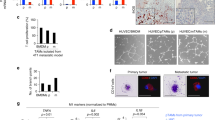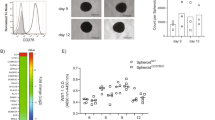Abstract
The aim of this study was to investigate whether tumor cells as well as tumor-associated macrophages (TAMs) contribute to the generation of protease activities essential to tumor cell invasiveness, such as matrix metalloproteinase 2 and 9 (MMP-2 and MMP-9), and the urokinase-type plasminogen activator (uPA) and uPA receptor (uPAR). We found that the enhanced invasiveness through Matrigel-coated filters of B16 murine melanoma cells stimulated with IFNγ was associated with an higher expression of uPAR and MMP-9 in these cells. Moreover, treatment with anti-MMP-9 or anti-uPAR monoclonal antibodies abrogated the increase of invasiveness in IFNγ-stimulated melanoma cells, suggesting a cooperation of uPA system and MMP-9 in cytokine-stimulated invasiveness. Invasiveness through Matrigel was also enhanced in B16 melanoma cells exposed to a medium conditioned by TAMs, represented in our experimental model by thioglycollate-elicited macrophages co-cultivated with melanoma cells. Macrophages isolated from these co-cultures were found to express higher levels of uPAR and MMP-9 compared to macrophage cultures alone, and the pro-invasive activity of the co-culture-conditioned medium was abrogated by anti-MMP-9 monoclonal antibodies, but not anti-uPAR monoclonal antibodies. Furthermore, the enhanced uPAR and MMP-9 expression in macrophages co-cultivated with tumor cells seems a rather specific phenomenon, generated through a cell-to-cell contact mechanism. On the whole, our data point to a cooperation between tumor cells and macrophages elicited by tumor cells themselves in generating key enzymes essential in the promotion of tumor invasiveness, such as uPAR and MMP-9.



Similar content being viewed by others
References
Andreasen PA, Kjoller L, Christensen L et al (1997) The urokinase-type plasminogen activator system in cancer metastasis: a review. Int J Cancer 72:1–22
Mignatti P, Rifkin DB (2000) Nonenzimatic interactions between proteinases and the cell surface: novel roles in normal and malignant cell physiology. Adv Cancer Res 78:103–157
Del Rosso M, Fibbi G, Pucci M et al (2002) Multiple pathways of cell invasion are regulated by multiple families of serine proteases. Clin Exp Metastasis 193:193–207
Egeblad M, Werb Z (2002) New functions for the matrix metalloproteinases in cancer progression. Nat Rev Cancer 2:161–174
Sidenius N, Blasi F (2003) The urokinase plasminogen activator system in cancer: recent advances and implication for prognosis and therapy. Cancer Metastasis Rev 22:205–222
De Vries TJ, Quax PH, Denijn M et al (1994) Plasminogen activators, their inhibitors, and urokinase receptor emerge in late stages of melanocytic tumor progression. Am J Pathol 144:70–81
Hofmann UB, Westphal JR, Van Muijen GN et al (2000) Matrix metalloproteinases in human melanoma. J Invest Dermatol 115:337–344
Hofmann UB, Westphal JR, Waas ET et al (1999) Matrix metalloproteinases in human melanoma cell lines and xenografts: increased expression of activated matrix metalloproteinase-2 (MMP-2) correlates with melanoma progression. Br J Cancer 81:774–782
D’Alessio S, Margheri F, Pucci M et al (2004) Antisense oligodeoxynucleotides for urokinase-plasminogen activator receptor have anti-invasive and anti-proliferative effects in vitro and inhibit spontaneous metastases of human melanoma in mice. Int J Cancer 110:125–133
Itoh T, Tanioka M, Matsuda H et al (1999) Experimental metastasis is suppressed in MMP-9-deficient mice. Clin Exp Metastasis 17:177–181
Bjorklund M, Heikkila P, Koivunen E (2004) Peptide inhibition of catalytic and noncatalytic activities of matrix metalloproteinase-9 blocks tumor cell migration and invasion. J Biol Chem 279:29589–29597
Liotta LA, Khon EC (2001) The microenvironment of the tumor–host interface. Nature 411:375–379
Fidler IJ (2002) The organ microenvironment and cancer metastasis. Differentiation 70:498–505
Fidler IF, Schroit AJ (1998) Recognition and destruction of neoplastic cells by activated macrophages: discrimination of altered self. Biochim Biophys Acta 948:151–173
Cecconi O, Calorini L, Mannini A et al (1997) Enhancement of lung-colonizing potential of murine tumor cell lines co-cultivated with activated macrophages. Clin Exp Metastasis 15:94–101
Calorini L, Mannini A, Bianchini F et al (1999) Biological properties associated with the enhanced lung-colonizing potential in a B16 murine melanoma line grown in a medium conditioned by syngeneic Corynebacterium parvum-elicited macrophages. Clin Exp Metastasis 17:889–895
Pollard JW (2004) Tumour-educated macrophages promote tumour progression and metastasis. Nat Rev Cancer 4:71–78
Sica A, Schioppa T, Mantovani A et al (2006) Tumour-associated macrophages are a distinct M2 polarised population promoting tumour progression: potential targets of anti-cancer therapy. Eur J Cancer 42:717–727
Lin EY, Nguyena AV, Russellb RG et al (2001) Colony-stimulating factor 1 promotes progression of mammary tumors to malignancy. J Exp Med 193:727–740
Fallani A, Calorini L, Mannini A et al (2006) Platelet-activating factor (PAF) is the effector of IFN gamma-stimulated invasiveness and motility in a B16 melanoma line. Prostaglandins Other Lipid Mediat 81:171–177
Gattoni-Celli S, Calorini L, Simile MM et al (1993) Modulation by MHC class I antigens of the biology of melanoma cells. Non immunological mechanism. Melanoma Res 3:285–289
Chen TR (1997) In situ detection of Mycoplasma contamination in cell cultures by fluorescent Hoechst 33258 stain. Exp Cell Res 104:255–262
Bianchini F, D’Alessio S, Fibbi G et al (2006) Cytokine-dependent invasiveness in B16 murine melanoma cells: role of uPA system and MMP-9. Oncol Rep 15:709–714
Thompson JE, Cubbon RM, Cummings RT et al (2002) Photochemical preparation of a pyridone containing tetracycle: a Jak protein kinase inhibitor. Bioorg Med Chem Lett 12:1219–1223
Jaleel M, Shenoy AR, Visweswariah SS (2004) Tyrphostins are inhibitors of guanylyl and adenylyl cyclases. Biochemistry 43:8247–8255
Gordon S (2003) Alternative activation of macrophages. Nat Rev Immunol 3:23–35
Kim J, Yu W, Kovalski K et al (1998) Requirement for specific proteases in cancer cell intravasation as revealed by a novel semiquantitative PCR-based assay. Cell 94:353–362
Lakka SS, Gondi CS, Dinh DH et al (2005) Specific interference of urokinase-type plasminogen activator receptor and matrix metalloproteinase-9 gene expression induced by double-stranded RNA results in decreased invasion, tumor growth, and angiogenesis in gliomas. J Biol Chem 280:21882–21892
Harvey SR, Hurd TC, Markus G et al (2003) Evaluation of urinary plasminogen activator, its receptor, matrix metalloproteinase-9, and von Willebrand factor in pancreatic cancer. Clin Cancer Res 9:4935–4943
Saito K, Takeha S, Shiba K et al (2000) Clinicopathologic significance of urokinase receptor- and MMP-9-positive stromal cells in human colorectal cancer: functional multiplicity of matrix degradation on hematogenous metastasis. Int J Cancer 86:24–29
Denkert C, Kobel M, Berger S et al (2001) Expression of cyclooxygenase 2 in human malignant melanoma. Cancer Res 61:303–308
Itoh T, Tanioka M, Matsuda H et al (1999) Experimental metastasis is suppressed in MMP-9-deficient mice. Clin Exp Metastasis 17:177–181
Huang S, Van Arsdall M, Tedjarati S et al (2002) Contributions of stromal metalloproteinase-9 to angiogenesis and growth of human ovarian carcinoma in mice. J Natl Cancer Inst 94:1134–1142
Hiratsuka S, Nakamura K, Iwai S et al (2002) MMP-9 induction by vascular endothelial growth factor receptor-1 is involved in lung-specific metastasis. Cancer Cell 2:289–300
Acknowledgements
This work was supported by grants from Murst ex 60% and Ente Cassa di Risparmio di Firenze.
Author information
Authors and Affiliations
Corresponding author
Additional information
This paper was presented in part at the “11th World Congress on Advances in Oncology and 9th International Symposium on Molecular Medicine” 12–14 October 2006, Hersonissos, Crete, Greece.
Rights and permissions
About this article
Cite this article
Marconi, C., Bianchini, F., Mannini, A. et al. Tumoral and macrophage uPAR and MMP-9 contribute to the invasiveness of B16 murine melanoma cells. Clin Exp Metastasis 25, 225–231 (2008). https://doi.org/10.1007/s10585-007-9136-0
Received:
Accepted:
Published:
Issue Date:
DOI: https://doi.org/10.1007/s10585-007-9136-0




